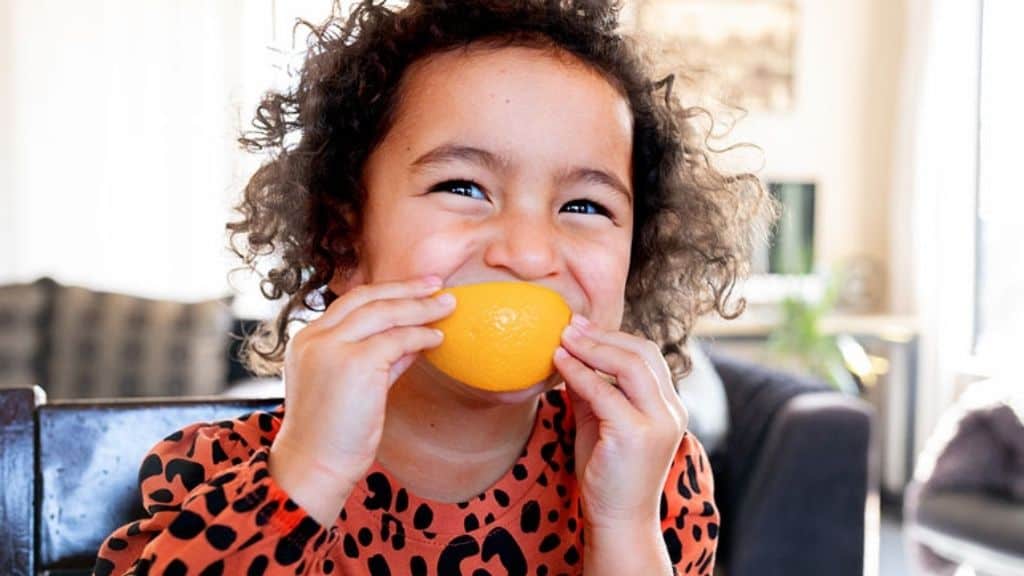
Parenthoodbliss selects the best products based on real-life testing conducted by our staff, members of our user community, the contributors, as well as through research and feedback by experts; here’s more about our product review process. The details and prices are accurate as per the publishing date and we may earn commissions through the shopping links on this blog.
Table of Contents
Vitamin C is an essential nutrient. Vitamin C is absolutely essential for your child’s health and growth. It helps red blood cells repair and enhances the immune system.
Several fruits and vegetables, especially those with a red or orange color, such as strawberries, red bell peppers, and oranges, contain vitamin C.
Although vitamin C deficiency in children is uncommon, if you’re concerned, you should still talk to your doctor about whether or not your child needs to take a supplement.
The growth and well-being of children depends on vitamin C. It helps the body build and repair red blood cells, bones, and tissues.
Moreover, it strengthens blood vessels, which lessens bruising from falls and scrapes, and supports your child’s gum health.
Vitamin C also strengthens the immune system, hastens wound healing, and guards against infection. Iron from food sources helps the body absorb it.
Vitamin C Requirements For Children And Toddlers
Here is the vitamin C dosage for kids:
15 mg per day for children ages 1 to 3.
4 to 8 years old: 25 mg daily
Although vitamin C is present in many foods, deficiencies are very uncommon. There may be a vitamin C deficiency in picky eaters’ who don’t consume enough fruits and vegetables. Also, children who are exposed to secondhand smoke may require extra vitamin C to reverse the effects of tobacco on their developing cells.
See your doctor about whether you should increase your child’s intake of vitamin C if you are worried that they aren’t receiving enough of it.
Your child does not need to consume vitamin C each day. Instead, try to space out the advised quantity over the course of a few days or a week.
Optimum Sources Of Vitamin C For Kids
As a general rule, red and orange fruits and vegetables are good providers of vitamin C. These foods contain a lot of vitamin C, albeit the amount varies a bit depending on the fruit or vegetable’s size.:
- 1/2 cup orange juice: 50 mg
- 1/4 cup papaya: 35 mg
- 1/4 cup raw tomato: 5 mg
- 1/4 cup guava: 94 mg
- 1/2 medium orange: 35 mg
- 1/4 cup potato, cooked without skin: 3 mg
- 1/2 cup broccoli: 51 mg
- 1/4 cup kiwi: 41 mg
- 1/4 cup mango: 15 mg
- 1/4 cup pink grapefruit: 23 mg
- 1/4 cup red bell pepper: 47.5 mg
- 1/4 cup spinach: 4.5 mg
- 1/4 cup cantaloupe: 17 mg
- 3 medium strawberries: 21 mg
How much vitamin C is too much for my kid?
Vitamin C is water-soluble, therefore any extra is eliminated in your child’s urine. Megadoses, however, can still cause gastritis, kidney stones, diarrhea, and nausea (inflammation of the stomach lining).
For children aged one to three, a megadose of vitamin C would be more than 400 milligrams per day. For children aged 4 to 8, a megadose is more than 650 mg per day. Use caution when giving a child a chewable supplement meant for adults because each tablet contains up to 500 mg.
A balanced diet delivers an appropriate quantity of nutrients, including vitamin C, for the majority of kids and adults. In reality, unless your child’s doctor feels they need one, the American Academy of Pediatrics (AAP) does not advise vitamin supplements for children.
Some neurodivergent children with autism spectrum disorders or sensory processing impairments may be very fussy eaters who find it difficult to eat foods high in vitamin C. If you are concerned about your child’s nutrition, discuss it with their physician to see whether a vitamin supplement is appropriate for them.










